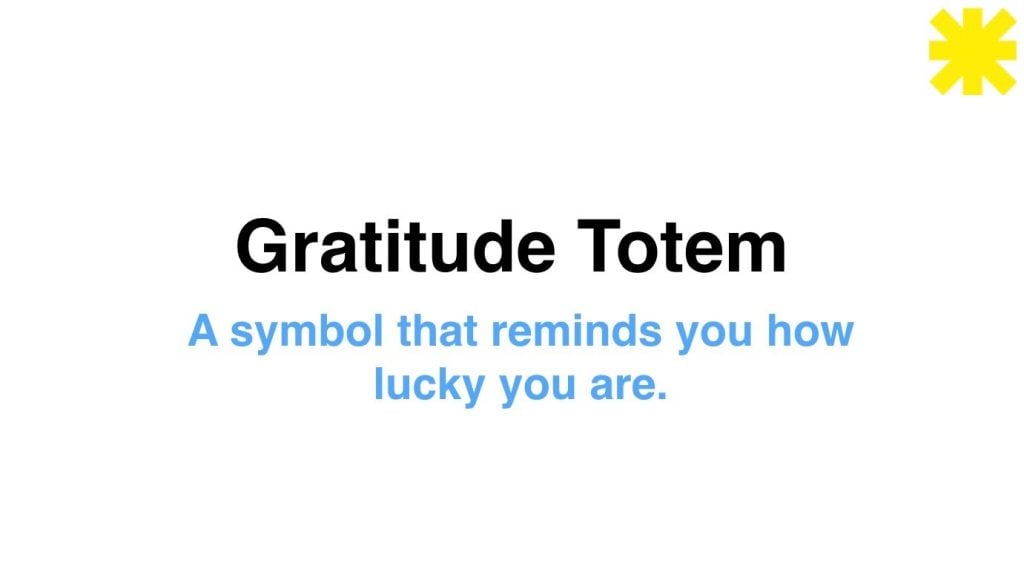You can learn how to be more grateful.
The research is clear: Gratitude is one of the simplest, most powerful ways to increase your life satisfaction.
And it’s free! But sometimes gratitude is a little like eating our vegetables: we all know it’s good for us (and our happiness), and we should definitely do it on a daily basis… but how often do we actually follow this advice?
We all want to be more grateful, but find it so hard to keep front of mind.
I am guilty of this too–of being a little too busy or a little too lazy to practice gratefulness. We end up in the unfortunate habit of taking the amazing things in our lives for granted and we forget to be grateful.
Well, we are about to change that! I want to teach you a super simple gratitude trick.
Are you ready?
It’s a tactic I call: A gratitude totem. This is an easy way of making gratitude an applicable, everyday practice that you can incorporate into even the busiest of busy lives.
A Gratitude Totem
What is a gratitude totem?
Totem (n): A totem is a symbol, reminder or representation that serves as an emblem. It helps to remind the user of an idea, memory or behavior.
A totem is a symbol that reminds us of something else. I like to use totems to remind me of good habits. In this case, gratitude.
The best way to be more grateful is to pick a symbol that reminds you of how important gratitude is for your happiness. It is my hope that your totem will remind you of everything to be grateful in the moment.

How Does it Work?
Simple: First, pick an object, process or person you see often (preferably everyday, but we’ll get there–baby steps). Whether it be fresh flowers on your desk, tying your shoes or seeing your sweet dog, whatever you pick will be your new gratitude totem.
Second, whenever you see that object, person, or do that thing. You will stop and think about what you’re grateful for.
For example, I converted something that frustrated me into something I use as my gratitude totem: an absurdly long red light near my house that I somehow always hit.
Instead of letting this red light annoy me and potentially ruin my good mood, I decided to change it. Now, whenever I’m stopped at this light-sometimes even multiple times a day-I take that time to think of all the things I’m grateful for:
- I am so grateful for living in the most beautiful and amazing city–Portland, Oregon.
- I am so grateful for waking up healthy.
- I am so grateful for my incredible husband, Scott!
No matter how simple or how grand, there are so many things to be grateful for and appreciate in our lives, every single day.
Totem Ideas
It can be difficult at first to pick your totem, but don’t overthink it. Here are some examples you could implement in your life:
- Objects
- Morning coffee or tea
- Flowers/plants around the house or office
- Processes
- My red light
- Walking the dog
- Times
- 11:11am
- Leaving the office at the end of the workday
- People
- Kissing your partner hello/goodbye/just because
- Your best friend’s text sound
My challenge to you now is to pick your gratitude totem
…and then share it! Tell your partner. Tell your friends. Then they can help remind you too!
Don’t take your surroundings for granted. Be present in the moment.
I’m grateful for you taking the time to join me in practicing gratitude today.

Wow that’s a unique idea that you have. Thanks for sharing, really helps me
Wow that’s a unique idea that you have. Thanks for sharing, really helps me
Wow that’s a unique idea that you have. Thanks for sharing, really helps me
Wow that’s a unique idea that you have. Thanks for sharing, really helps me
I use a stone I picked up at the beach in NZ 20+ years ago. Great idea.
I use a stone I picked up at the beach in NZ 20+ years ago. Great idea.
I use a stone I picked up at the beach in NZ 20+ years ago. Great idea.
I use a stone I picked up at the beach in NZ 20+ years ago. Great idea.
Feathers…. I find them everywhere…. Reminding me of the powers protection (Angles). I make a point of picking them up and counting my blessings.
Coins on pavements – I pick them up and I’m reminded that I am blessed with so much more than I deserve.
Feathers…. I find them everywhere…. Reminding me of the powers protection (Angles). I make a point of picking them up and counting my blessings.
Coins on pavements – I pick them up and I’m reminded that I am blessed with so much more than I deserve.
Feathers…. I find them everywhere…. Reminding me of the powers protection (Angles). I make a point of picking them up and counting my blessings.
Coins on pavements – I pick them up and I’m reminded that I am blessed with so much more than I deserve.
Feathers…. I find them everywhere…. Reminding me of the powers protection (Angles). I make a point of picking them up and counting my blessings.
Coins on pavements – I pick them up and I’m reminded that I am blessed with so much more than I deserve.